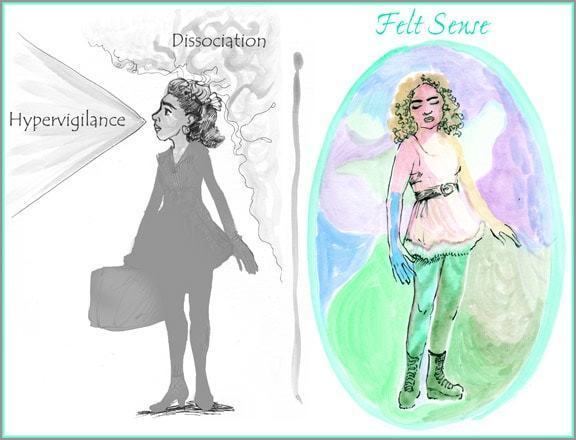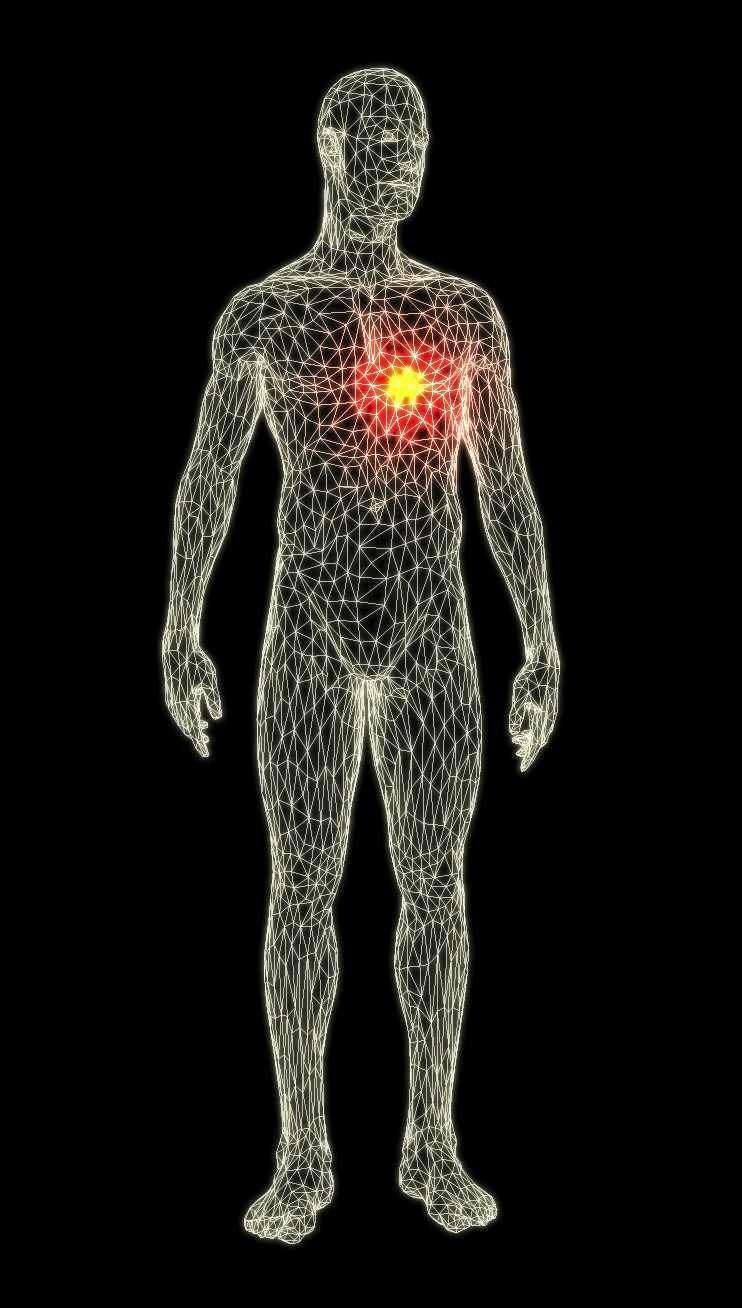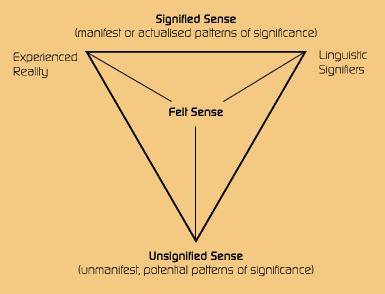 | ||
Focusing is a psychotherapeutic process which can be used in any kind of therapeutic situation, including peer-to-peer sessions. It involves holding a kind of open, non-judging attention to an internal knowing which is directly experienced but is not yet in words. Focusing can, among other things, be used to become clear on what one feels or wants, to obtain new insights about one's situation, and to stimulate change or healing. Focusing is set apart from other methods of inner awareness by three qualities: something called the "felt sense", a quality of engaged accepting attention, and a researched-based technique that facilitates change.
Contents
- Focusing in one direction
- Origin
- Felt sense and felt shift
- Learning and using Focusing
- Focusing oriented Psychotherapy
- Variety of teaching styles
- References

Focusing in one direction
Origin

At the University of Chicago, beginning in 1953, Eugene Gendlin did 15 years of research analyzing what made psychotherapy either successful or unsuccessful. The conclusion was that it is not the therapist's technique that determines the success of psychotherapy, but rather the way the patient behaves, and what the patients do inside themselves during therapy sessions.

Gendlin found that, without exception, the successful patient intuitively focuses inside on a very subtle and vague internal bodily awareness—or "felt sense"—which contains information that, if attended to, holds the key to the resolution of the problems the patient is experiencing. The word "Focusing" refers to the process by which a bodily sense which is definitely present, but murky, fuzzy and inarticulate comes gradually into focus by this inner attentiveness.

"Focusing" is a process and learnable skill which re-creates this successful-patient behavior in a form that can be taught to other patients. Gendlin detailed the techniques in his book Focusing which, intended for the layperson, is written in conversational terms and describes the six steps of Focusing and how to do them. Gendlin stated: "I did not invent Focusing. I simply made some steps which help people to find Focusing."
"Felt sense" and "felt shift"

The "felt sense" is the unclear, pre-verbal sense of "something" as that "something" is experienced in the body. It is an inner knowledge or awareness that has not been consciously thought or verbalized. A felt sense is more complex or layered than a simple emotion. This bodily felt "something" may be an awareness of a situation or an old hurt, or of something that is "coming"—perhaps an idea or insight. A felt sense is by definition unclear and vague, and it is always more than any attempt to express it verbally. Gendlin described it as "sensing an implicit complexity, a wholistic sense of what one is working on".

The Focusing process is a method for making a felt sense -- which is otherwise fuzzy and murky, and sometimes confusing -- more tangible and easier to work with. To help the felt sense form and to accurately identify its meaning, the focuser tries out words that might express it. These words can be tested against the felt sense in the step called "resonating": a word, phrase or description of imagery that accurately describes a felt sense will create a sense of resonance. If the word or phrase does not adequately describe it, the Focuser tries again to see if other words do resonate.
In the Focusing process, Focusers turn their attention to the not-yet-articulated knowing called the felt sense. As a felt sense forms, there are often long pauses, sometimes with sounds which express something inarticulately, such as a simple "uh...." When the felt sense comes a bit more into focus, the Focuser will describe it aloud, with whatever words seem to fit, even if they don't make rational sense to the mind. Sometimes concrete imagery might emerge, such as "I see myself like a child sitting against a high wall," or abstract imagery such as, "It feels like something shiny and pulsating." The right words to describe the felt sense might not emerge as imagery at all; any words that fit are tried; examples could be, "It feels powerful," or "There's a part of me that feels clouded," or "Something about this is like the time I went sailing with my father." Once the person has put some tentative words to the felt sense, they check whether the words, phrases or images they've described "resonate." New words often come then, either because the first words chosen aren't exactly right, or perhaps because they were just right, and that has allowed more to unfold. If enough time and non-judgmental attention is given to the felt sense, then a felt movement or "felt shift" comes. Articulating the felt sense as it comes into focus often brings insights into the situation from which the felt sense arose. Often this leads the person to be able to move beyond the "stuck" place with fresh insights, and also sometimes indications of steps to take.
Learning and using Focusing
One can learn the Focusing technique from one of several books, or from a Focusing trainer or practitioner. Focusing is easiest to sense and do in the presence of a "listener"—either a Focusing trainer, a therapist, or a layperson trained in Focusing. Gendlin's book details six steps in Focusing,, but Focusing is taught in many ways that don't always involve these defined steps.
Focusing is now practiced all over the world by thousands of people in professional settings with Focusing trainers, and informally between laypersons. As a stand-alone process, a Focusing session can last from approximately 15 minutes to an hour, on average—with the "Focuser" being listened to, and their verbalized thoughts and feelings being reflected back to them by, the "listener" or "companion". Generally speaking, but not always, the focuser has their eyes closed, in order to more accurately focus inwardly on their "felt sense" and the shifts that take place from it. Focusing can also be done alone.
Focusing-oriented Psychotherapy
Focusing is often practiced by individuals not in a psychotherapeutic context, but therapists throughout the world use Focusing as either one of their therapeutic options, or as the primary way in which they interact with their clients. In 1996, Gendlin published a comprehensive book on Focusing-oriented psychotherapy. Since then, Focusing-oriented therapy (FOT) has grown throughout the world and the International Focusing Institute offers certification in it. The Focusing-oriented psychotherapist attributes a central importance to the client's capacity to be aware of his "felt sense", and the meaning behind his words or images. The client is encouraged to sense into feelings and meanings which are not yet formed. Other elements of Focusing are also incorporated into the therapy practice so that Focusing remains the basis of the process—allowing for inner resonance and verification of ideas and feelings, and allowing new and fresh insights to come from within the client. In 2014, two volumes documented recent developments and trends in FOT: "Theory and Practice of Focusing-Oriented Psychotherapy: Beyond the Talking Cure" and "Emerging Practice in Focusing-Oriented Psychotherapy: Innovative Theory and Applications," both edited by Greg Madison.
Variety of teaching styles
Although Gendlin originally elaborated six steps of Focusing, many other ways of teaching the practice have developed over the years. One popular process is taught by Ann Weiser Cornell, called Inner Relationship Focusing. Domain Focusing, developed by Robert Lee, teaches Focusers to pay attention to three "domains": the felt sense, self empathy, and thinking. Biospiritual Focusing, developed by Ed McMahon and Peter Campbell, integrates Focusing with Christian spirituality. Recovery Focusing, developed by Suzanne Noel, integrates Focusing with 12-step recovery work. Wholebody Focusing incorporates the Alexander Technique with Focusing. Besides these (and other) defined methods of teaching, individual teachers of Focusing informally develop their own styles. The International Focusing Institute, the international certifying body for Focusing professionals, has a history of encouraging innovation as part of the ethos of Focusing.
Other developments in Focusing include Focusing alone using a journal or a sketchbook. Drawing and painting can be used with Focusing processes with children. Attention to the felt sense naturally takes place in all manner of processes where something new is being formed: for example in creative process, learning, thinking, and decision making.
